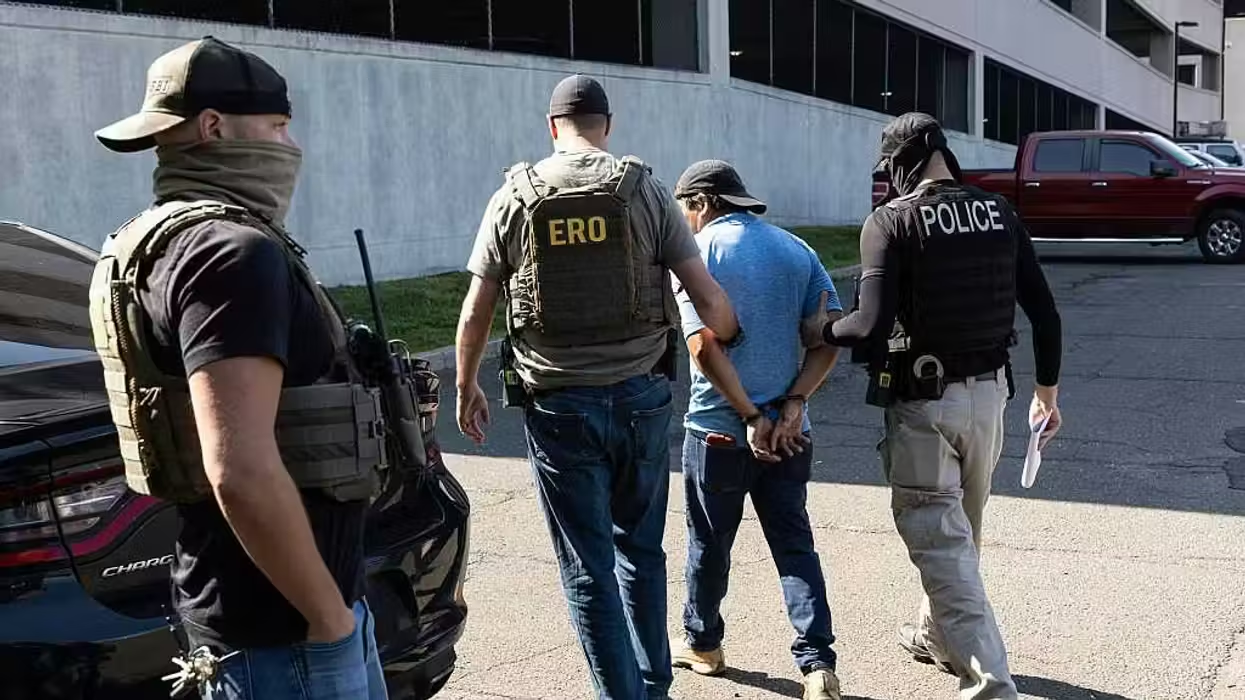MIAMI (TheBlaze/AP) — Two particularly hungry, exotic termite species apparently have found love halfway around the world and the results are disturbing.
 A light-colored female Formosan termite, left, exhibits mating behavior with the darker male Asian termite in Florida. The two highly destructive species may be breeding where their habitats overlap in South Florida. (AP/Thomas Chouvenc, University of Florida/IFAS)
A light-colored female Formosan termite, left, exhibits mating behavior with the darker male Asian termite in Florida. The two highly destructive species may be breeding where their habitats overlap in South Florida. (AP/Thomas Chouvenc, University of Florida/IFAS)
Asian and Formosan subterranean termites are two of the most destructive termite species in the world, responsible for much of the estimated $40 billion in economic losses attributed to termites annually. Their habitat ranges overlap in lush South Florida, already home to a daunting number of invasive plant and animal species thriving where they should not. Each termite invaded Florida, probably through cargo shipments, several decades ago, but experts believed the colonies didn't mingle because their aboveground mating swarms launched in different months.
That is, until University of Florida researcher Thomas Chouvenc noticed something unusual about the termite swarms in his Fort Lauderdale neighborhood two years ago.
The two species were flying around looking for mates at the same time — and they were giving each other that look.
“This is worrisome, as the combination of genes between the two species results in highly vigorous hybridized colonies that can develop twice as fast as the two parental species,” Chouvenc said in a statement. “The establishment of hybrid termite populations is expected to result in dramatically increased damage to structures in the near future.”
 Damage to wood caused by Asian and Formosan termites in Florida. (AP/Thomas Chouvenc, University of Florida/IFAS)
Damage to wood caused by Asian and Formosan termites in Florida. (AP/Thomas Chouvenc, University of Florida/IFAS)
The research is preliminary and leaves many questions unanswered, but the idea of a hybrid termite carrying the destructive capabilities of two invasive species concerns top experts.
"That's big news," said Matthew Messenger, an entomologist at the U.S. Department of Agriculture. "They're two bad ones, too."
Chouvenc is the lead author of a study published Wednesday in the journal PLOS ONE detailing observations of Asian and Formosan termite swarms in downtown Fort Lauderdale and then in a lab at UF's Institute of Food and Agricultural Sciences.
In the field, including Chouvenc's own yard, researchers documented the two species swarming at the same time and in the same places. The same behavior was documented again last year, and Chouvenc said he's seeing again this spring.
"What we didn't expect to see was when they're in the same place at the same time, we saw the male Asian subterranean termites looking for the female Formosan termites in the field," Chouvenc said.
"When we put them in vials and brought them back to the lab, to our biggest surprise they started laying eggs and the eggs started growing."
Watch the swarm in this video from New Scientist:
The resulting "hybrid" colony in the lab grew more vigorously than colonies produced by either species alone, researchers said. Genetic analysis confirmed they were looking at a hybrid species.
Similar hybridization has been documented in invasive bee and fire ant species, but not in termites. The two termite species also are found together on the island of Oahu in Hawaii and in Taiwan, but the simultaneous swarms and hybridization found in Florida appears to be a new phenomenon.
It's still unknown whether a hybrid colony has survived in the wild in Fort Lauderdale, or whether the hybrids bred in the lab can reproduce. Female termites can lay millions of eggs, but it takes five to eight years for a colony to produce the mature adults that fly in the mating swarms.
"Let's keep our fingers crossed that they're not able [to reproduce] and that they're donkey termites," said Messenger, who reviewed the data but did not participate in the UF study.
Even if hybrid termites can't reproduce, they could cause damage over many years. Alone, each species is a challenge to control. Their below-ground colonies are bigger than those of native termites and can be hard to find.
“Because a termite colony can live up to 20 years with millions of individuals, the damaging potential of a hybrid colony remains a serious threat to homeowners even if the hybrid colony does not produce fertile winged termites,” Nan-Yao Su, an entomology professor at the University of Florida, said in a statement. “This is especially true when the colony exhibits hybrid vigor as we witnessed in the laboratory.”
The Formosan termites originated in China but now are established throughout the Southeast and blamed for roughly $300 million in property damage each year in New Orleans alone. Asian termites normally found in tropical southeastern Asia have spread to Brazil, the Caribbean and South Florida.
Asian termites aren't expected to spread farther north in the U.S. than South Florida because they don't tolerate colder weather, but a hybrid might be able to thrive in a greater range than either species alone.
Liquid insecticides injected into the soil or baited traps are effective ways for homeowners to fight back against Asian and Formosan termites, and those methods should work against any hybrid, Messenger said.

 A light-colored female Formosan termite, left, exhibits mating behavior with the darker male Asian termite in Florida. The two highly destructive species may be breeding where their habitats overlap in South Florida. (AP/Thomas Chouvenc, University of Florida/IFAS)
A light-colored female Formosan termite, left, exhibits mating behavior with the darker male Asian termite in Florida. The two highly destructive species may be breeding where their habitats overlap in South Florida. (AP/Thomas Chouvenc, University of Florida/IFAS)
 Damage to wood caused by Asian and Formosan termites in Florida. (AP/Thomas Chouvenc, University of Florida/IFAS)
Damage to wood caused by Asian and Formosan termites in Florida. (AP/Thomas Chouvenc, University of Florida/IFAS)






